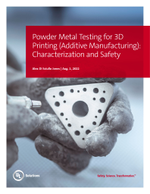
Powder Metal Testing for 3D Printing (Additive Manufacturing): Characterization and Safety
Characteristics of powder metals may affect their use in additive manufacturing. Learn about the processes used to identify potential hazards and evaluate powder metals for 3D printing in this white paper.

Additive manufacturing, also referred to as 3D printing, is an established approach advanced by the rapid acceleration of innovations, such as using powder metal in 3D printing. 3D-printed parts now perform critical functions in industries that rely on quality parts, from aerospace and defense to medical and dental to consumer goods and electronics.
The powder metals used in 3D printing can enhance the overall product’s performance but may require precautions for safe use during manufacturing.
Perhaps even more important than the characteristics affecting the finished part are those that increase safety in work environments. It is essential to know whether a powder is flammable or explosive and, if it is, whether there are safe conditions that can help prevent this hazard so that such substances can be handled accordingly.
Besides providing information on the possible mechanical and electrical properties of a manufactured part, a complete understanding of the powder's chemistry can help determine whether a powder poses a health hazard, such as being toxic, caustic, mutagenic or carcinogenic.
Read our white paper to deepen your understanding of how to determine the safety and suitability of powder metals for use in additive manufacturing, and identify potential hazards.

Powder Metal Testing for 3D Printing (Additive Manufacturing): Characterization and Safety
Thanks for your interest in our products and services. Let's collect some information so we can connect you with the right person.